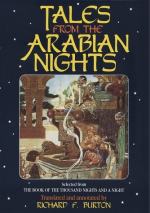[FN#81] Mohammed’s companions (Ashab), numbering some five hundred, were divided into two orders, the Muhajirin (fugitives) or Meccans who accompanied the Apostle to Al-Medinah (Pilgrimage ii. 138) and the Ansar (Auxiliaries) or Medinites who invited him to their city and lent him zealous aid (Ibid. ii. 130). The terms constantly occur in Arab history.
[FN#82] The “Mosque of the Troops,” also called Al-Fath (victory), the largest of the “Four Mosques:” it is still a place of pious visitation where prayer is granted. Koran, chap. xxxiii., and Pilgrimage ii. 325.
[FN#83] Arab. “Al-Wars,” with two meanings. The Alfaz Adwiyah gives it=Kurkum, curcuma, turmeric, safran d’Inde; but popular usage assigns it to Usfur, Kurtum or safflower (carthamus tinctorius). I saw the shrub growing all about Harar which exports it, and it is plentiful in Al-Yaman (Niebuhr, p. 133), where women affect it to stain the skin a light yellow and remove freckles: it is also an internal remedy in leprosy. But the main use is that of a dye, and the Tob stained with Wars is almost universal in some parts of Arabia. Sonnini (p. 510) describes it at length and says that Europeans in Egypt call it “Parrot-seeds” because the bird loves it, and the Levant trader “Saffrenum.”
[FN#84] Two men of the great ’Anazah race went forth to gather Karaz, the fruit of the Sant (Mimosa Nilotica) both used for tanning, and never returned. Hence the proverb which is obsolete in conversation. See Burckhardt, Prov. 659: where it takes the place of “ad Graecas Kalendas.”
[FN#85] Name of a desert (Mafazah) and a settlement on the Euphrates’ bank between Basrah and the site of old Kufah near Kerbela; the well known visitation place in Babylonian Irak.
[FN#86] Of the Banu Sulaym tribe; the adjective is Sulami not Sulaymi.
[FN#87] Arab. “Amam-ak"=before thee (in space); from the same root as Imam=antistes, leader of prayer; and conducing to perpetual puns, e.g. “You are Imam-i (my leader) and therefore should be Amam-i” (in advance of me).
[FN#88] He was angry, as presently appears, because he had heard of certain love passages between the two and this in Arabia is a dishonour to the family.
[FN#89] Euphemy for “my daughter.”
[FN#90] The Badawin call a sound dollar “Kirsh hajar” or “Riyal hajar” (a stone dollar; but the word is spelt with the greater h).
[FN#91] Arab. Burdah and Habarah. The former often translated mantle is a thick woollen stuff, brown or gray, woven oblong and used like a plaid by day and by night. Mohammed’s Burdah woven in his Harem and given to the poet, Ka’ab, was 7 1/2 ft. long by 4 1/2: it is still in the upper Serraglio of Stambul. In early days the stuff was mostly striped; now it is either plain or with lines so narrow that it looks like one colour. The Habarah is a Burd made in Al-Yaman and not to be confounded with the Egyptian mantilla of like name (Lane, M. E. chapt. iii.).




